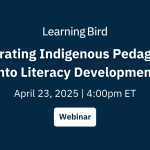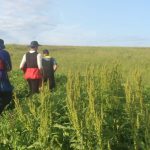Earth Day 2022: Invest in Our Planet
As we approach Earth Day on April 22, 2022, many educators wonder how to explore and discuss the annual theme with learners. The past few years have been quite tumultuous here on Earth. Many of us reflected and rethought our day-to-day lives in a globalized world amid lockdowns, quarantines, and uncertainty. The theme for Earth Day 2022 is “Invest in Our Planet.” This article will explore ideas for integrating this theme and Earth Day into your teaching.
How will you celebrate Earth Day 2022 with your learners, and more importantly, how will you teach them to invest in our planet 365 days a year? Keep reading for some Earth Day 2022 inspiration!
The Seventh Generation Principle
We can encourage learners to invest in our planet by shifting our perspectives and exploring Indigenous ways of knowing and being in the world. Eurocentric worldviews tend to value the planet’s resources only as sources of economic gain. This worldview does not consider the consequences of using resources in this way. Indigenous worldviews have a different perspective on resource management. One Haudenesonee teaching is the Seventh Generation Principle. This teaching asks us to consider the effects of our actions on ourselves and the seven generations that will follow us. It includes our relationships with other humans and the natural world. Many Indigenous worldviews do not see humans as separate from the natural world.
Researchers found that Indigenous-managed lands have the highest levels of biodiversity of vertebrate species. Partnering with Indigenous communities is essential for ensuring the survival of diverse species. Invite learners to imagine Earth’s appearance if more people understand and follow the Seventh Generation Principle. Have them gather their thoughts in artistic or written expression and share them with the community for Earth Day.
How can we talk about the climate crisis and still have hope?
The climate crisis is already upon us, but it is never too late to do as much as we can. It’s important to be truthful with learners, but it can be hard to present these facts and then motivate them to take action. If you are looking for a way to present the facts and spread hope, something that truly inspired me during the pandemic was The Year the Earth Changed. This documentary shares so many uplifting stories about the effects of a global lockdown on our planet. Throughout the 48-minute run time, I lost count of how many times I said, “Wow!”
After watching, consider asking learners if human actions negatively affect wildlife or other humans in their communities. What steps can we take to mitigate these effects? Perhaps your learners can write letters to local politicians, create awareness campaigns or even organize a peaceful protest.
How can I encourage learners to “invest” in our planet?
Investing in our planet can seem like something reserved for governments and large corporations. Large organizations may have more economic power, but individuals are not powerless against climate change. We can start thinking about food waste, the length of supply chains, and green energy. Remind learners that individual choices impact ourselves and those who follow us. Instilling these values and empowering learners to pressure governments and corporations is a huge step in the right direction. Governmental and organizational leaders are often disconnected from Indigenous communities. They have not decolonized their Western corporate mindset. They often see environmental concerns as a cost to operations. Raising awareness at the individual level can help create change. Partnerships with Indigenous communities are opportunities to prosper and save our planet simultaneously.
Learn From Indigenous Knowledges
Encourage learners to invest in our planet by exploring Indigenous ways of knowing and being. While lots of information is available online, the best way to learn about Indigenous communities is by connecting with them! Consider inviting local Indigenous community members to speak with learners or visiting a local cultural centre. Suppose you’re unsure how to connect with an Indigenous community. In that case, reach out to your local Friendship Centre to help create relationships and learn the correct cultural Protocols.
Invest in Indigenous communities. Partner with them and amplify their voices. That is a meaningful way to celebrate Earth Day. It is also an action we can carry forward daily on a meaningful journey toward reconciliation and protecting our planet.
How will you encourage learners to invest in our planet? Will you be connecting with Indigenous communities? We’d love to hear your stories. Please share them with us here!







